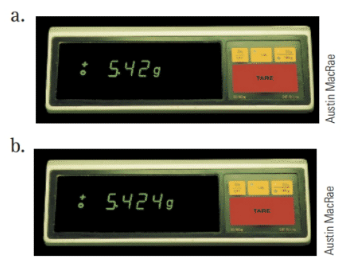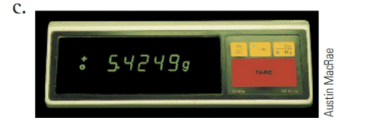
Chemistry In Focus
6th Edition
ISBN: 9781305544727
Author: Tro
Publisher: Cengage
expand_more
expand_more
format_list_bulleted
Concept explainers
Textbook Question
Chapter 2, Problem 52E
Consider each of the following balances. Which one is the most precise? Which one is the least? How much uncertainty is associated with each balance?


Expert Solution & Answer
Trending nowThis is a popular solution!

Students have asked these similar questions
esc
2
Incorrect
Feedback: Your answer is incorrect.
Can the molecule on the right-hand side of this organic reaction be made in good yield from no more than two reactants, in one step, by moderately heating
the reactants?
? A
O
• If your answer is yes, then draw the reactant or reactants in the drawing area below. You can draw the reactants in any arrangement you like.
. If your answer is no, check the box under the drawing area instead.
Check
F1
!
@
X
C
Save For Later
Submit Assignment
2025 McGraw Hill LLC. All Rights Reserved. Terms of Use | Privacy Center | Accessibility
80
et
A
ད
1
4
F2
F3
F4
F5
F6
F7
F8
F9
F10
F11
F12
#
$
45
%
A
6
87
&
*
8
9
)
0
+ ||
Can the molecule on the right-hand side of this organic reaction be made in good yield from no more than two reactants, in one step, by moderately heating
the reactants?
?A
Δ
O
• If your answer is yes, then draw the reactant or reactants in the drawing area below. You can draw the reactants in any arrangement you like.
• If your answer is no, check the box under the drawing area instead.
Explanation
Check
Click and drag to start drawing a structure.
2025 McGraw Hill LLC. All Rights Reserved. Terms of Use | Privacy Center | Accessibilit
ku
F11
१
eq
ine teaching and × +
rn/takeAssignment/takeCovalentActivity.do?locator-assignment-take
[Review Topics]
[References]
Write an acceptable IUPAC name for the compound below. (Only systematic names, not common names are accepted by this question.)
Keep the information page open for feedback reference.
The IUPAC name is
In progress
mit Answer
Retry Entire Group
5 more group attempts remaining
Cengage Learning | Cengage Technical Support
Save and Exit
Chapter 2 Solutions
Chemistry In Focus
Ch. 2 - The volume of a liquid can be measured with a...Ch. 2 - Scientific Notation Express the number 0.0000023...Ch. 2 - Prob. 2SCCh. 2 - Prob. 3SCCh. 2 - Converting Between Units Convert 34.0 cm to...Ch. 2 - Prob. 2.3YTCh. 2 - Extracting Information from Graphical Data The...Ch. 2 - Solving Word Problems...Ch. 2 - Solving Word Problems Involving Units Raised to a...Ch. 2 - Prob. 2.7YT
Ch. 2 - Prob. 2.8YTCh. 2 - Without doing any calculations, determine whether...Ch. 2 - Prob. 1ECh. 2 - Prob. 2ECh. 2 - Prob. 3ECh. 2 - What is the difference between reporting the...Ch. 2 - Prob. 5ECh. 2 - Prob. 6ECh. 2 - Prob. 7ECh. 2 - Prob. 8ECh. 2 - Prob. 9ECh. 2 - What is a conversion factor? Give two examples of...Ch. 2 - Prob. 11ECh. 2 - Identify the decimal part, the exponential part,...Ch. 2 - What is density? Give two examples of possible...Ch. 2 - Since oil floats on water, what can you say about...Ch. 2 - Express each of the following in scientific...Ch. 2 - Express each of the following numbers in...Ch. 2 - Express each of the following in decimal notation:...Ch. 2 - Express each of the following in decimal notation:...Ch. 2 - The circumference of Earth at the equator is...Ch. 2 - The distance from New York to Los Angeles is 2777...Ch. 2 - A can of soda contains 12 fluid ounces. What is...Ch. 2 - A laboratory beaker can hold 150mL. How many fluid...Ch. 2 - A car has a fuel efficiency of 27 miles per...Ch. 2 - A European rental car can travel 17 km on a liter...Ch. 2 - Perform each of the following conversions within...Ch. 2 - Perform each of the following conversions within...Ch. 2 - Prob. 27ECh. 2 - Perform the following conversions between the...Ch. 2 - A pond has a surface area of 1552m2. Convert this...Ch. 2 - An orange has a volume of 54cm3. Convert this...Ch. 2 - Prob. 31ECh. 2 - Prob. 32ECh. 2 - A runner runs at a pace of 8.5 minutes per mile....Ch. 2 - A driver drives an average speed of 58 miles per...Ch. 2 - A sports utility vehicle gets 12 miles per gallon...Ch. 2 - A hybrid electric vehicle (HEV) is a car with both...Ch. 2 - The following graph shows the concentration of an...Ch. 2 - The following graph shows the historical...Ch. 2 - A 28.4-cm3 sample of titanium has a mass of...Ch. 2 - A 1.5-cm3 sample of silicon has a mass of 3.5 g....Ch. 2 - A 5.00-L sample of pure glycerol has a mass of...Ch. 2 - A 3.80-mL sample of mercury has a mass of 51.4g....Ch. 2 - Ethylene glycol (antifreeze) has a density of...Ch. 2 - A thief plans to steal a bar of gold from a womans...Ch. 2 - Prob. 45ECh. 2 - A proton has a radius of approximately 110-13 cm...Ch. 2 - What did Einstein mean when he said, The most...Ch. 2 - Prob. 48ECh. 2 - Prob. 49ECh. 2 - Prob. 50ECh. 2 - Prob. 51ECh. 2 - Consider each of the following balances. Which one...Ch. 2 - Each of the following coins is photographed to...Ch. 2 - Obtain an outdoor thermometer and record the...
Knowledge Booster
Learn more about
Need a deep-dive on the concept behind this application? Look no further. Learn more about this topic, chemistry and related others by exploring similar questions and additional content below.Similar questions
- Draw the molecules.arrow_forwardDraw the mechanism for the acid-catalyzed dehydration of 2-methyl-hexan-2-ol with arrows please.arrow_forward. Draw the products for addition reactions (label as major or minor) of the reaction between 2-methyl-2-butene and with following reactants : Steps to follow : A. These are addition reactions you need to break a double bond and make two products if possible. B. As of Markovnikov rule the hydrogen should go to that double bond carbon which has more hydrogen to make stable products or major product. Here is the link for additional help : https://study.com/academy/answer/predict-the-major-and-minor-products-of-2-methyl- 2-butene-with-hbr-as-an-electrophilic-addition-reaction-include-the-intermediate- reactions.html H₂C CH3 H H3C CH3 2-methyl-2-butene CH3 Same structure CH3 IENCESarrow_forward
- Draw everything on a piece of paper including every single step and each name provided using carbons less than 3 please.arrow_forwardTopics] [References] Write an acceptable IUPAC name for the compound below. (Only systematic names, not common names are accepted by this question.) Keep the information page open for feedback reference. H The IUPAC name isarrow_forward[Review Topics] [References] Write an acceptable IUPAC name for the compound below. (Only systematic names, not common names are accepted by this question.) Keep the information page open for feedback reference. The IUPAC name is Submit Answer Retry Entire Group 9 more group attempts remainingarrow_forward
- Please draw.arrow_forwardA chromatogram with ideal Gaussian bands has tR = 9.0 minutes and w1/2 = 2.0 minutes. Find the number of theoretical plates that are present, and calculate the height of each theoretical plate if the column is 10 centimeters long.arrow_forwardAn open tubular column has an inner diameter of 207 micrometers, and the thickness of the stationary phase on the inner wall is 0.50 micrometers. Unretained solute passes through in 63 seconds and a particular solute emerges at 433 seconds. Find the distribution constant for this solute and find the fraction of time spent in the stationary phase.arrow_forward
- Consider a chromatography column in which Vs= Vm/5. Find the retention factor if Kd= 3 and Kd= 30.arrow_forwardTo improve chromatographic separation, you must: Increase the number of theoretical plates on the column. Increase the height of theoretical plates on the column. Increase both the number and height of theoretical plates on the column. Increasing the flow rate of the mobile phase would Increase longitudinal diffusion Increase broadening due to mass transfer Increase broadening due to multiple paths You can improve the separation of components in gas chromatography by: Rasing the temperature of the injection port Rasing the temperature of the column isothermally Rasing the temperature of the column using temperature programming In GC, separation between two different solutes occurs because the solutes have different solubilities in the mobile phase the solutes volatilize at different rates in the injector the solutes spend different amounts of time in the stationary phasearrow_forwardplease draw and example of the following: Show the base pair connection(hydrogen bond) in DNA and RNAarrow_forward
arrow_back_ios
SEE MORE QUESTIONS
arrow_forward_ios
Recommended textbooks for you
 Chemistry: The Molecular ScienceChemistryISBN:9781285199047Author:John W. Moore, Conrad L. StanitskiPublisher:Cengage Learning
Chemistry: The Molecular ScienceChemistryISBN:9781285199047Author:John W. Moore, Conrad L. StanitskiPublisher:Cengage Learning Principles of Modern ChemistryChemistryISBN:9781305079113Author:David W. Oxtoby, H. Pat Gillis, Laurie J. ButlerPublisher:Cengage Learning
Principles of Modern ChemistryChemistryISBN:9781305079113Author:David W. Oxtoby, H. Pat Gillis, Laurie J. ButlerPublisher:Cengage Learning
 Introductory Chemistry: A FoundationChemistryISBN:9781337399425Author:Steven S. Zumdahl, Donald J. DeCostePublisher:Cengage Learning
Introductory Chemistry: A FoundationChemistryISBN:9781337399425Author:Steven S. Zumdahl, Donald J. DeCostePublisher:Cengage Learning Chemistry & Chemical ReactivityChemistryISBN:9781337399074Author:John C. Kotz, Paul M. Treichel, John Townsend, David TreichelPublisher:Cengage Learning
Chemistry & Chemical ReactivityChemistryISBN:9781337399074Author:John C. Kotz, Paul M. Treichel, John Townsend, David TreichelPublisher:Cengage Learning Chemistry & Chemical ReactivityChemistryISBN:9781133949640Author:John C. Kotz, Paul M. Treichel, John Townsend, David TreichelPublisher:Cengage Learning
Chemistry & Chemical ReactivityChemistryISBN:9781133949640Author:John C. Kotz, Paul M. Treichel, John Townsend, David TreichelPublisher:Cengage Learning

Chemistry: The Molecular Science
Chemistry
ISBN:9781285199047
Author:John W. Moore, Conrad L. Stanitski
Publisher:Cengage Learning

Principles of Modern Chemistry
Chemistry
ISBN:9781305079113
Author:David W. Oxtoby, H. Pat Gillis, Laurie J. Butler
Publisher:Cengage Learning


Introductory Chemistry: A Foundation
Chemistry
ISBN:9781337399425
Author:Steven S. Zumdahl, Donald J. DeCoste
Publisher:Cengage Learning

Chemistry & Chemical Reactivity
Chemistry
ISBN:9781337399074
Author:John C. Kotz, Paul M. Treichel, John Townsend, David Treichel
Publisher:Cengage Learning

Chemistry & Chemical Reactivity
Chemistry
ISBN:9781133949640
Author:John C. Kotz, Paul M. Treichel, John Townsend, David Treichel
Publisher:Cengage Learning
Measurement and Significant Figures; Author: Professor Dave Explains;https://www.youtube.com/watch?v=Gn97hpEkTiM;License: Standard YouTube License, CC-BY
Trigonometry: Radians & Degrees (Section 3.2); Author: Math TV with Professor V;https://www.youtube.com/watch?v=U5a9e1J_V1Y;License: Standard YouTube License, CC-BY